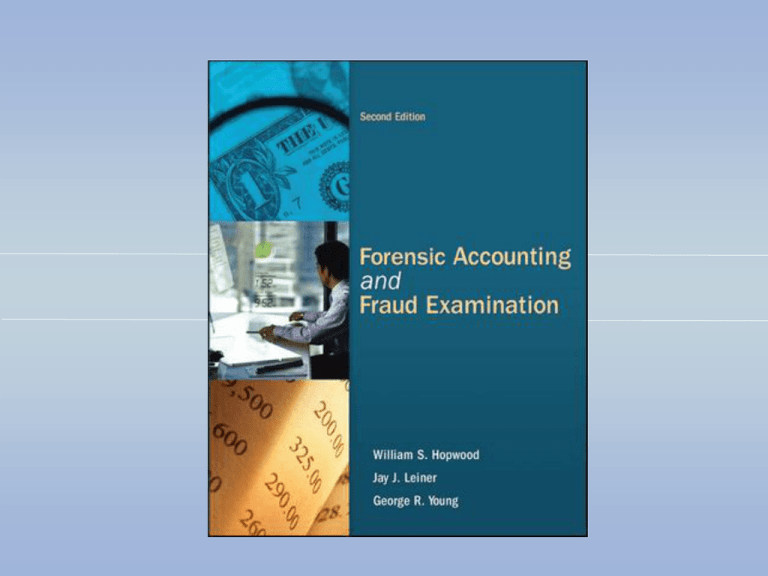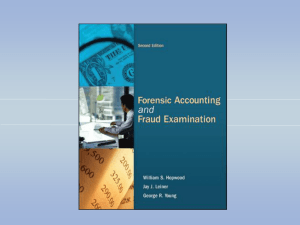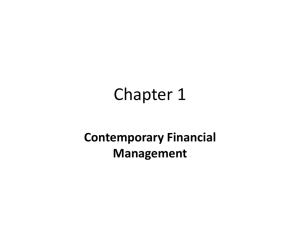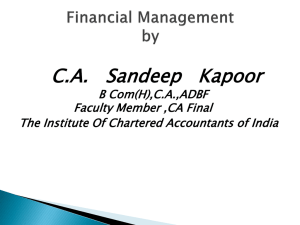
14-1
14-2
14
Financial Statement Fraud
McGraw-Hill/Irwin
Copyright © 2012 by The McGraw-Hill Companies, Inc. All rights reserved.
14-3
Financial Statement Fraud:
Overview
Financial
statement fraud (FSF) is any undisclosed
intentional or grossly negligent violation of generally
accepted accounting principles (GAAP) that materially
affects the information in any financial statement.
COSO reported various general areas for FSF schemes:
Improper
revenue recognition.
Overstatement of assets (other than accounts receivable
related to revenue fraud).
Understatement of expenses/liabilities.
Misappropriation of assets.
Inappropriate disclosure.
Other miscellaneous techniques.
About
half of all FSFs involve overstating revenues/assets.
14-4
Revenue Schemes
Sham
sales
Premature revenue recognition
Recognition of conditional sales
Abuse of cutoff date of sales
Misstatement of the percentage of completion\
Unauthorized shipments or channel stuffing
Consignment sales
14-5
Schemes Involving
Overstating Assets
Inventories
The most common inventory fraud involves the
overstatement of assets.
Accounts
receivable
Property,
plant, and equipment
Accounts receivable are overstated by
understating allowances for bad debts or falsifying accounts
balances.
In this scheme,
depreciation is not taken when it should be or property, plant,
and equipment is simply overstated. A corresponding
overstatement is made to the revenues.
Other
overstatements These involve other accounts such as
loans/notes receivables, cash, investments, and so on.
14-6
Schemes Involving Improper
Accounting Treatment
Recording
an asset at market value or some other incorrect
value rather than cost.
Failing to charge proper depreciation or amortization
against income.
Capitalizing an asset when it should be expensed.
Improperly recording transfers of goods from related
companies as sales.
Not recording liabilities to keep them off the balance sheet.
Omitting contingent liabilities (e.g., pending product liability
lawsuits, pending government fines, and so on) from the
financial statements.
14-7
Other Schemes
Fictitious
and Fraudulent Transactions Recording sham
transactions and legitimate transactions improperly.
Fraudulent
Transaction Processing Intentionally
misprocessing transactions to produce fraudulent account
balances. For example, accounting software is modified to
incorrectly total sales and accounts receivables so that all
transactions in the account are real but the total is overstated.
Direct
Falsification of Financial Statements Producing
false financial statements when management ignores account
balances.
14-8
Characteristics of Financial
Statement Fraud
The
median amount of the fraud is approximately 25
percent of the median total assets.
Most frauds span multiple fiscal periods with the average
fraud time being approximately two years.
The majority of fraud involves overstating revenues by
recording them fictitiously or prematurely.
FSF is much more likely to occur in companies whose
assets are less than $100 million.
FSF is much more likely to occur in companies with
decreased earnings, earnings problems, or a downward
trend in earnings.
14-9
Characteristics of Financial
Statement Fraud
In
a large majority of cases, either the CFO or CEO is
involved in the fraud.
In many cases, the board of directors has no audit
committee or one that seldom meets, or none of the audit
committee members has the required skills to perform as
intended.
The members of the board are frequently dominated by
insiders (even related to managers) or by those with
financial ties to the company.
Auditor changes occurred about one-fourth of the time in
and around the time of the fraud.
14-10
Characteristics of Financial
Statement Fraud
Nearly
half of audit reports indicate some type of anomaly,
such as a change of auditors, doubts about the company’s
ability to continue as a going concern, a change in
accounting principle, or a litigation issue. Problems with
departures from GAAP seldom occur, however.
The size of the audit firm does not seem to matter. FSF
occurs frequently in companies audited by both large and
small audit firms.
Nearly one-third of the enforcement action cases that name
individuals allege wrongdoing on the part of the external
auditor. About half the time, the auditor is accused of
participating in a fraud; the other half the time the auditor is
accused of negligence.
14-11
Motives for FSF
Poor
Income Performance
Impaired Ability to Acquire Capital.
Product Marketing
General Business Opportunities
Compliance with Bond Covenants
Generic Greed
Theft, Bribery, or Other Illegal Activities
14-12
Prevention of Financial
Statement Fraud
The general philosophy behind SOX is to minimize FSF by
promoting strong corporate governance and
organizational oversight through the oversight of the
following six organizational groups.
Board of directors
Audit committee
Management
Internal auditor
External auditor
Public Oversight Bodies
14-13
Prevention of Financial
Statement Fraud
14-14
Red Flags: Indications of Possible
Financial Statement Fraud
Lack
of Independence, Competence, Oversight, or
Diligence
Weak Internal Control Processes
Management Style
Personnel-Related Practices
Accounting Practices
Company’s Financial Condition
Industry Environment and Conditions
14-15
Management Discretion, Earnings
Management, And Earnings Manipulation
Management
Discretion. With respect to accounting
discretion, its legitimate use does not violate any ethics
guidelines although some individuals complain about its
use and would like it eliminated. Managers also make use
of economic discretion.
The term earnings management is used frequently confused
with earnings manipulation. The term earnings management
refers to management’s routine use of nonfraudulent accounting
and economic discretion.
Earnings
manipulation has a more nebulous meaning. It can
refer either to the legitimate or aggressive use, or fraudulent
abuse, of discretion. By definition, then, earnings management is
legitimate, and earnings manipulation can be legitimate,
marginally ethical, unethical, or illegal, depending on its extent.
14-16
Earnings Smoothing and
Earnings Management
Earnings
smoothing is the manipulation of earnings to
reduce their volatility. In simple terms, this means using
manipulations to increase earnings in years when they are
weak and to lower them in years when they are strong.
It’s very well known on Wall Street that investors prefer
steadily increasing earnings that consistently meet or
exceed financial analyst expectations. This stems from the
general economic principle that investors are risk averse.
In financial terms, risk aversion is associated with earnings
volatility.
14-17
Cookie Jar and Big Bath
Accounting
Cookie
Jar Accounting One type of earnings management
and earnings manipulation. The practice treats the balance sheet
as a cookie jar: In good years, the company stores cookies
(reserves) in the cookie jar (the balance sheet) so that it can take
them out and eat them (place them on the income statement)
when management is hungry (needs extra income to look good).
Big-Bath
Accounting When a company makes a large one-
time write off, it is said to take a big bath to improve future
earnings. Many companies take a big bath (often in the form of
restructuring or inventory write-downs) when earnings
performance is already poor.
14-18
Cases Of Financial Statement
Fraud And Manipulation
McKesson
& Robbins: Financial Statement Fraud 101.
The Great Salad Oil Swindle
Equity Funding: They Made a Movie about It
Cedant Corporation: Manufacturing Revenues
Zzzz Best: The Teenager Who Fooled Wall Street
Sunbeam Corp.: Channel Stuffing
Nortel: The Ultimate Big Bath
WorldCom: Boosting Earnings in a Big Way
Enron: Lessons in Creative Accounting
Qwest and Global Crossing: Swap Sales









